Air conditioning using off-the-grid solar [sample setup/install]
Summary: brief article describing a setup for running a good sized air-conditioner using solar in an entirely off the grid environment.
My family has lived off-the-grid for a number of years and generally it has been a wonderful experience. However, summers in Missouri can get rather warm so this year I set out to cool our entire house with AC. Previously only our bedroom was air conditioned and the other rooms had ceiling fans or stationary fans.
Prior to the “full home” AC project, our solar setup was as follows:
- (9) 200 watt Sharp solar panels (1,800 total watts)
- (4) 12V HUP Solar One batteries (two sets in series, then wired in parallel, for 24V total)
- (1) Xantrex Prosine 1800 watt pure-sine wave inverter
- (1) OutBack FM 80 charge controller
The only change required for full house AC has been adding:
- (1) Tripp Lite PV2400FC PV 2400W 24V DC to AC modified-sine wave inverter
Amazon.com: Tripp Lite PV2400FC PV 2400W 24V DC to AC Inverter Plus with Charge/Load LED’s: Electronicshttp://www.amazon.com/gp/product/B00006HNTE/ref=as_li_ss_tl?ie=UTF8&tag=pixensity-20&linkCode=as2&camp=217153&creative=399701&creativeASIN=B00006HNTETechnical Details PowerVerter Plus Heavy-Duty Inverter, industrial-strength power for heavy-duty applications 2400 watts continuous output power; up to 4800 watts instantaneous…
- and of course the air conditioner itself!
Amazon.com: Frigidaire FRA106BU1 10,000 BTU Compact Window Air Conditioner: Home & Gardenhttp://www.amazon.com/gp/product/B004P8K38C/ref=as_li_ss_tl?ie=UTF8&tag=pixensity-20&linkCode=as2&camp=217153&creative=399701&creativeASIN=B004P8K38C10,000 BTU cooling capacity Cools room sizes up to 500 sq. ft. 8-way air direction control Antimicrobial mesh filter; Tilt-out filter access Electronic controls
Here’s a brief rundown on those two component choices:
#1 Inverter
My existing Xantrex ProSine 1800 watt inverter should have been able to handle the Frigidaire AC unit with no problems. Specifically the FRA106BU1 AC unit has a max draw of 925 watts. The ProSine inverter has a continuous output rating of 1800 watts. Theoretically this would allow the ProSine to easily power the Frigidaire with plenty of capacity left to spare (1800w-925w=875 watts excess capability).
However, the ProSine would only run for about 30 minutes before reaching a thermal threshold and shutting down (it has an internal temperature probe attached to one of the heatsinks). The fan on the ProSine had gone bad recently and I was using two external fans (one at the air intake and one at the exhaust point) to cool it so I assumed insufficient cooling was the problem. I replaced the internal fan and still had the same results. The operating environment for the ProSine was fairly warm to begin with so perhaps in a cooler setting the ProSine would have been okay.
The eventual solution that I chose was to use TWO inverters. One for heavy-duty loads and one for sensitive electronics.
Specifically, I purchased a heavier-duty modified sine wave inverter to use for the air-conditioner and my other heavy loads (motors, compressors) and kept the ProSine operating for sensitive electronics equipments (computers, communications equipment etc.)
Links about “Pure” Sine Wave vs “Modified” Sine Wave inverters
After reading those links you may get the impressions that modified sine wave (or “square” wave) inverters suck. In my opinion, however, they simply serve a different purpose. If you have a use application that runs well on a modified sine wave inverter then a pure sine wave inverter is overkill.
Also, the price difference between the two types of inverters can be substantial:
$450 USD for a 24V 2400W Tripp Lite modified sine wave inverter
vs.
$2,000+ USD for an Xantrex 24V 2000W pure sine wave inverter.
#2 Air Conditioner
I have been very impressed with Frigidaire air conditioners. From their small 6000BTU units all the way up to 15000BTU they seem to perform admirably. I chose a middle of the road 10000BTU Frigidaire AC unit for our purposes and it has performed admirably.
TIP: prices tend to go UP in the summer for AC units, so looks for some bargains in the winter!
How is everything working?
Splendidly. Our house is fairly small and the Tripp Lite has no problem running the Frigidaire unit as much as we want. Typically this has been from about 11AM (when the house starts warming up) to about 7:30PM (when the temps outside start cooling down). Of course the AC doesn’t need to be cooling all the time, it simply kicks on when the set temperature is reached. we generally set it at about 76 degrees Fahrenheit.
One of the great things about electricity from solar is that you get plenty of sunshine in the hottest parts of the year. Without the AC we’d have quite a surplus of electricity that we wouldn’t be using. With out current setup, the AC allows us to utilize more of what we were already producing.
Finally, I would be remiss if I failed mention that the best way to cool your house is by making sure it energy efficient in the first place: good insulation, having shade trees (or other sources of shade) if possible, and generally anything you can do to keep the sun’s hot rays off and out of your house! Generally if you are able to do all of that, simple ceiling fans and/or an attic fan (for when you want to pull in cool air or exhaust hot air) may be sufficient. If not, and your house is still too warm, then AC can certainly be pretty nice. 🙂
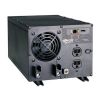
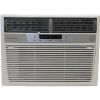
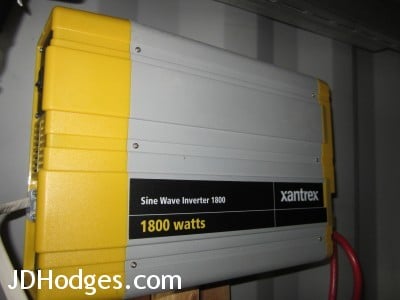
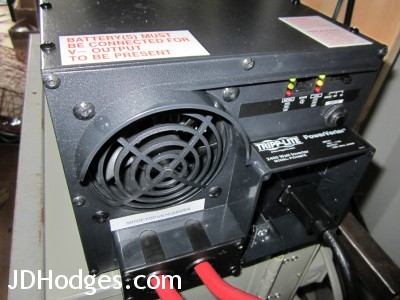


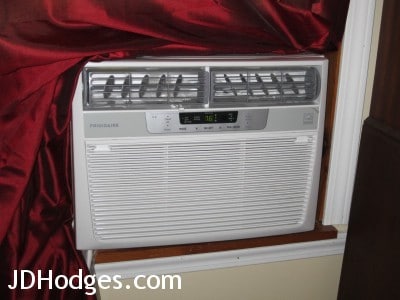
Thank you for this, my dream is to live off the grid! Now I know I can have AC too if I want 🙂 Thx again!
You are very welcome Meagen! I hope your off-the-grid dream soon becomes a reality 🙂
Best regards,
-JD
Hey JD, thanks for keeping your info available–hope to escape to “the country” in a few years and get us a small home and off-grid power setup : – )
Rob and Cindy in Center Point AL
Hi Robert,
I’m sorry that I did not see and reply to this message earlier. Thank you for commenting and reading my blog 🙂 I hope that you were able to move to the country and get a good setup 👍
Thanks again, hope you are having a GREAT day/week.
Best regards,
-J.D.